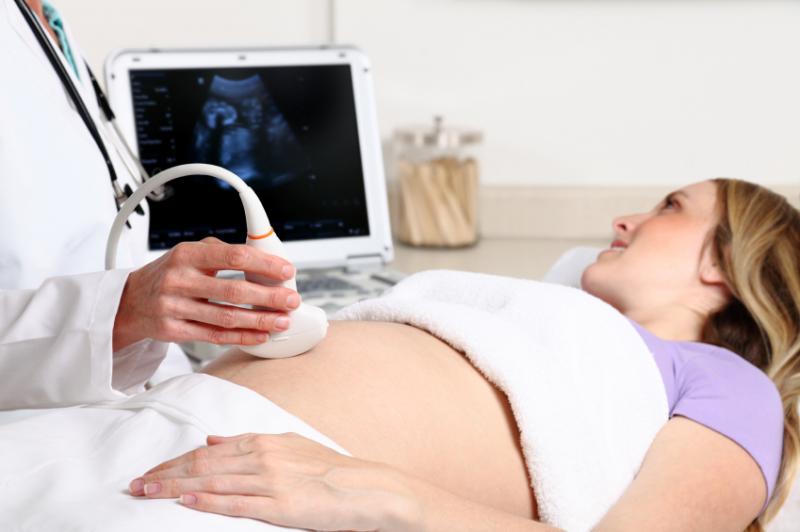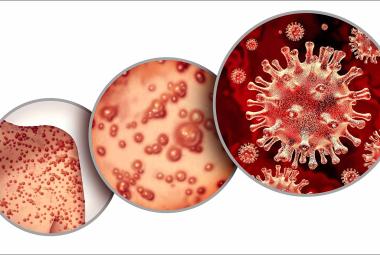Although most radiological procedures do not increase the risk of congenital malformations during pregnancy, any procedure that is not essential during pregnancy should be delayed until after delivery. Radiological procedures may be classified into two types: (1) diagnostic, and (2) therapeutic. Diagnostic procedures become necessary when a condition arises during pregnancy that needs medical evaluation such as appendicitis. Therapeutic procedures become necessary when a diagnosis has been determined and medical treatment is required during pregnancy such as hyperthyroidism.
Diagnostic imaging uses both non-ionizing and ionizing radiation. Non-ionizing procedures include magnetic resonance imaging (MRI) and ultrasound. Non-ionizing radiation does not appear to increase the incidence of congenital malformations or miscarriage; therefore, MRI and ultrasound are the preferred methods of imaging during pregnancy. Ionizing procedures include x-rays, CT (computed tomography), angiography, fluoroscopy, and nuclear medicine studies. The risks of ionizing radiation during pregnancy depend on several factors such as distance of the fetus from the beam and/or radioactive agent, the dose of radiation given and the specific agent used, the fetal gestational age at the time of exposure, and the length of time of the exposure.
In general, single diagnostic imaging procedures are not expected to expose the fetus to significant radiation doses. Total radiation exposure below five rads or 0.05 Gy (gray) is considered to be non-teratogenic. The American College of Obstetrics and Gynecology (ACOG) recommends if multiple imaging is required that medical professionals with expertise in calculating dosimetry should be consulted to give the estimated total fetal dose of radiation exposure that is expected. (1-5)
Diagnostic imaging uses several types of contrast agents to improve visualization of the organ or body system in question. These types of contrast agents include iodinated, barium, gadolinium derivatives, and ferrous oxide derivatives. Of these contrast agents, gadolinium is contraindicated during the first trimester of pregnancy because the agent may collect in the amniotic fluid and expose the fetus to high radiation doses. Gadolinium should be used only when absolutely necessary in the second and third trimesters. (6) Iodine 131 is contraindicated throughout pregnancy because the agent has a detrimental effect on the thyroid gland of the fetus. (7) The other contrast agents should be used during pregnancy only if required to make a definitive diagnosis.
There are different risks for radiation exposure (doses above 5 rads) depending on the fetal gestational age. In the first two weeks of gestation, no malformations occur but the risk of fetal death is greatest. From two weeks to eight weeks, when fetal organs are forming, the risk of malformations is greatest especially of the central nervous system (CNS). After eight weeks through 20 weeks, the risk of malformations decreases. After 20 weeks gestation, the fetal risk of malformations is over. After 26 weeks gestation, the radiation effect is similar to the newborn. Another risk of in utero radiation exposure is a small increased risk of developing cancer in the first or second decade of life. The risk is small, approximately two percent more than the general population. (8)
Therapeutic radiological procedures during pregnancy are used primarily for the treatment of cancer and hyperthyroidism. Therapeutic radiation doses often exceed the 5 rad limit for recommended fetal exposure; therefore, irradiation should be delayed until the second or third trimester if possible. Whole body fetal dose should be limited to 0.10 Gy or less. Lead shielding and above the diaphragm radiation should be used to protect the fetus from radiation scatter. Other techniques to limit direct radiation exposure to the fetus include IMRT (intensity modulated radiation therapy) where the radiation intensity can be increased or decreased during the treatment session, and 3-D conformed therapy where the radiation beams are shaped to match the tumor, again limiting radiation exposure to the fetus.
There are also environmental radiation risks that may affect pregnancy. Occasionally the sun has intense radiation periods that can adversely affect pregnant in-flight workers who fly on long transcontinental flights. These workers must adjust their schedules to minimize environmental radiation exposure. (9) Pregnant imaging workers must also adjust their schedules so that they are not exposed to a large amount of radiation per day such as being exposed to more than six 99m-Tc (radiopharmaceutical) studies daily.
In summary, diagnostic imaging, in most cases, does not expose the fetus to excess amounts of radiation. Therapeutic radiation does have the potential to cause fetal harm and thus measures to decrease the amount of radiation exposure of the fetus should be instituted. Patients should be counseled on the risks of radiation during pregnancy so they may make informed decisions prior to exposure.
References:
- Cunningham G, Leveno, K., Bloom, S., Hauth, J., Rouse, D., and Spong, C. General Considerations and Maternal Evaluation. McGraw Hill Medical.
- Lowe SA. Diagnostic radiography in pregnancy: risks and reality. Aust N Z J Obstet Gynaecol. Jun 2004;44(3):191-196.
- Kanal E, Barkovich AJ, Bell C, et al. ACR guidance document for safe MR practices: 2007. AJR Am J Roentgenol. Jun 2007;188(6):1447-1474.
- ACOG Committee Opinion. Number 299, September 2004 (replaces No. 158, September 1995). Guidelines for diagnostic imaging during pregnancy. Obstet Gynecol. Sep 2004;104(3):647-651.
- De Santis M, Di Gianantonio E, Straface G, et al. Ionizing radiations in pregnancy and teratogenesis: a review of literature. Reprod Toxicol. Sep-Oct 2005;20(3):323-329.
- Chen MM, Coakley FV, Kaimal A, Laros RK, Jr. Guidelines for computed tomography and magnetic resonance imaging use during pregnancy and lactation. Obstet Gynecol. Aug 2008;112(2 Pt 1):333-340.
- RSNA Aa. Radioiodine (I-131) Therapy for Hyperthyroidism. 3/15/2010. Available at: www.radiologyinfo.org/en/info.cfm?pg=radioiodine. Accessed 6/8/2010, 2010.
- CDC. Possible Health Effects of Radiation Exposure on Unborn Babies. May 10, 2006. Accessed 3/25/10, 2010.
- Barish RJ. In-flight radiation exposure during pregnancy. Obstet Gynecol. Jun 2004;103(6):1326-1330.







